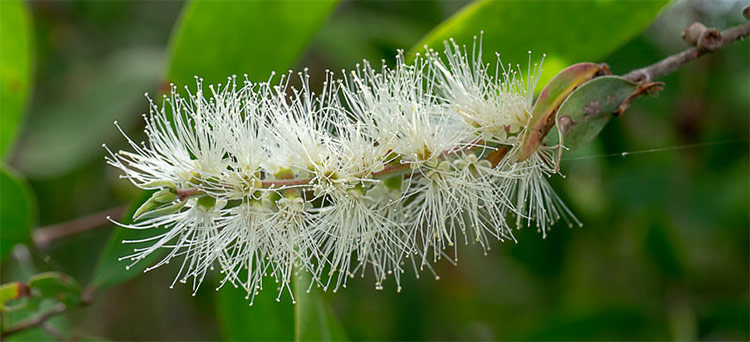Niaouli Essential Oil
Melaleuca quinquenervia

Description
Niaouli is also sometimes known as the Broad-Leaved Paperbark Tree or the Paper Bark Tea Tree. Niaouli Essential Oil is also sometimes referred to directy by its botanical name of Melaleuca Quinquenervia Essential Oil. As with all essential oils, it's important to doublecheck the botanical name of the oil that you are working with.
Niaouli isn't the greatest smelling essential oil. What it lacks in aromatic appeal, however, it makes up for in its therapeutic benefits. It's an excellent choice for use with respiratory concerns, skin infections and acne. Refer to the Niaouli Essential Oil Uses section below for more benefits.
The aroma is camphorous, earthy and a bit harsh. It's never a good idea to form an opinion of the aroma of an essential oil by simply smelling it straight from the bottle. This holds especially true for Niaouli Essential Oil. The characteristics of the aroma are more appealing when it is assessed on a fragrance testing strip. The aroma softens and marries well with other essential oils, particularly other medicinal and camphorous essential oils like Tea Tree, Rosemary 1,8 Cineole CT and Eucalyptus. Niaouli Essential Oil also blends well with essential oils in the wood, mint, spice and citrus families.

Niaouli Essential Oil is generally not utilized for emotional wellness applications. Due to its cineole content and composition of monoterpenes, however, it is a naturally stimulating essential oil.
Niaouli Essential Oil Benefits and Uses
- Bronchitis
- Respiratory Tract Disorders
- Influenza
- Sinus Congestion
- Sore Throats
- Catarrh
- Coughs
- Colds
- Uterine Infections
- Rheumatism
- Muscular Injury
- Rashes
- Pimples
- Acne
- Herpes
- Wounds
- Cuts
- Grazes
- Insect Repellent
Source: Valerie Ann Worwood, The Complete Book of Essential Oils and Aromatherapy, 25th Anniversary Edition (Novato, CA: New World Library, 2016, 609.
Botanical Name
Plant Family
Common Method of Extraction
Steam Distilled
Plant Part Typically Used
Color
Clear
Consistency
Thin
Perfumery Note
Middle
Strength of Initial Aroma
Medium
Aromatic Description
Niaouli Essential Oil is camphorous, earthy and musty.
Sustainability and Conservation Status
Least Concern
Source: https://www.iucnredlist.org/species/49278407/49278461
To learn more about the conservation status of essential oil bearing plants and how to use the IUCN Red List of Threatened Species, please refer to AromaWeb's Guide to Essential Oils and Sustainability.
Major Constituents for 1,8-Cineole Chemotype of Niaouli Essential Oil:
- 1,8-Cineole
- a-Pinene
- (+)-Limonene
- a-Terpineol
- B-Pinene
- Viridiflorol
See Essential Oil Safety for more complete list of typical constituents.
Source: Private Communication: McGilvray, 1999. Source cited in Robert Tisserand and Rodney Young, Essential Oil Safety (Second Edition. United Kingdom: Churchill Livingstone Elsevier, 2014), 364.
Niaouli 1,8-Cineole Chemotype Essential Oil Safety Information
Tisserand and Young indicate that Niaouli Essential with the 1,8-Cineole chemotype may cause CNS and breathing problems in young children. They caution against using the oil on or near the face of infants and children. Reading Tisserand and Young's full profile for this and the other Niaouli chemotypes is recommended. [Robert Tisserand and Rodney Young, Essential Oil Safety (Second Edition. United Kingdom: Churchill Livingstone Elsevier, 2014), 364.]
General Safety Information
Do not take any oils internally and do not apply undiluted essential oils, absolutes, CO2s or other concentrated essences onto the skin without advanced essential oil knowledge or consultation from a qualified aromatherapy practitioner. For general dilution information, read AromaWeb's Guide to Diluting Essential Oils. If you are pregnant, epileptic, have liver damage, have cancer, or have any other medical problem, use oils only under the proper guidance of a qualified aromatherapy practitioner. Use extreme caution when using oils with children and be sure to first read the recommended dilution ratios for children. Consult a qualified aromatherapy practitioner before using oils with children, the elderly, if you have medical issues or are taking medications. Before using this or any essential oil, carefully read AromaWeb's Essential Oil Safety Information page. For in-depth information on oil safety issues, read Essential Oil Safety by Robert Tisserand and Rodney Young.
Shelf Life
Important Information About the Profiles
The essential oil information provided on AromaWeb is intended for basic educational purposes only. The references to safety information, test results, constituents and percentages is generalized information. Essential oils can vary greatly in composition. The data is not necessary complete and is not guaranteed to be accurate. The essential oil photos are intended to represent the typical and approximate color of each essential oil. However, essential oil composition and color can vary based on harvesting, distillation, age of the essential oil and other factors. Profiles for several CO2 Extracts and absolutes are included within the directory, and are denoted as such.
